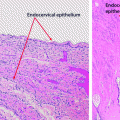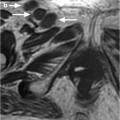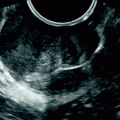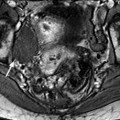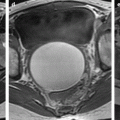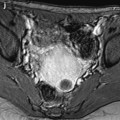Jean Noel Buy1 and Michel Ghossain2
(1)
Service Radiologie, Hopital Hotel-Dieu, Paris, France
(2)
Department of Radiology, Hotel Dieu de France, Beirut, Lebanon
Abstract
These are tumors other than those in the sex cord-stromal and steroid cell categories that are characterized [1] by (1) a stroma that is morphologically compatible with steroid hormone secretion and (2) clinical biochemical or pathologic incidence of endocrine abnormalities [2] of estrogenic androgenic or rarely progestogenic type, or a combination of them.
13.1 Definition
These are tumors other than those in the sex cord-stromal and steroid cell categories that are characterized [1] by (1) a stroma that is morphologically compatible with steroid hormone secretion and (2) clinical biochemical or pathologic incidence of endocrine abnormalities [2] of estrogenic androgenic or rarely progestogenic type, or a combination of them.
In 1958, Hughesdon [3] described serous, mucinous, clear cell, and endometrioid tumors associated with what he termed a “thecal reaction” of the stroma. In four of six cases in which the uterus was available, the endometrium showed cystic hyperplasia.
Such observations, as well as frequency of vaginal bleeding and the association of endometrioid hyperplastic conditions in patients with ovarian epithelial tumors, suggest some of these nonfunctioning tumors do demonstrate endocrine activity, which in most instances is of the estrogenic type.
13.2 Frequency and Distribution
Ovarian tumors with functioning stroma (OTFSs) are common at least at a laboratory level [4]. Approximately, 50% of postmenopausal women with benign and malignant surface epithelial-stromal tumors or carcinomas metastatic to the ovary have elevated urinary estrogen levels (5). Endocrine manifestations are much rarer. Few if any estrogenic tumors of this type have been reported in women in the reproductive age group because of the difficulty in establishing a cause-and-effect relationship between an ovarian tumor and estrogenic manifestations in that age category. There are over 60 reported examples of virilizing ovarian tumors with functioning stroma, slightly over one third of which occurred in pregnant women. Some of these women had virilized offspring as well [1]. Rare tumors are associated with progestational changes manifested by a decidual reaction [6, 7] or an Arias-Stella change in the endometrium.
13.3 Mechanism of Hormone Secretion
The explanation for the stromal stimulation is not clear. The high level of circulating luteinizing hormone in postmenopausal women could be responsible for stromal stimulation. Progressive expansion of aggregates of tumor cells could exert mechanical pressure on the stroma, stimulating it to transform into homono-producing tissue. Carcinoma cells may have aromatase activity and therefore a capacity to convert androgens to estrogens [8].
13.4 Microscopy Findings and Histochemical Investigations
The functioning stroma of the tumor may be its intrinsic stroma which is derived from the ovarian stroma, the stroma adjacent to the tumor, or a combination of the two [9]. The stromal cells transform into plump spindle cells resembling theca externa cells, theca lutein cells, stromal lutein cells, or a combination of these cell types, or rarely into Leydig cells [9].
Histochemical investigation of the luteinized stromal cells demonstrated that, in addition to their lipid content, these cells contained different oxidative enzymes as G6P-dehydrogenase or lactic acid dehydrogenase. Scully and Cohen [10] called them enzymatically active stromal cells (EASC).
Stay updated, free articles. Join our Telegram channel

Full access? Get Clinical Tree


